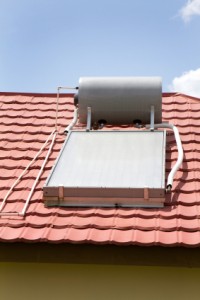
Solar-heated water can be used for showering, dish washing, etc., as well as for radiant heating in the home. In a grid-free home, it can be the primary means of heating as well as a constant, renewable source of hot water for all types of uses.
Solar water heating systems are also easier and cheaper to install, can last the lifetime of the home, and can provide hot water for nearly every day of the year in most climates.
The system you choose will depend on your budget, needs, and expected uses. There are two basic types of systems: active and passive, using either direct or convection heating. Active systems are pumped and circulated using external power (often from a small solar panel or other electrical source), and passive systems are moved by natural convection (the expansion and contraction of liquid with heat).
Active systems are more common and are generally capable of higher capacities than are passive systems, but the active system will require more maintenance and an electrical source. Passive systems are usually not as large-capacity and are not nearly as high-performance, but are generally more maintenance-free than active systems.
Whichever is used, the heating method is either direct or convection. Direct heating is not as common in the far north, since it involves moving the water through the eating elements themselves, which can lead to freezing in cold temperatures. Convection heating is more common as more heat-conductive liquids with anti-freeze properties can be used. These collect heat in the panels and travel through a water tank or coiled water pipe to convey the heat to the water, circulating back up to be re-heated in the panels again. Convection heating allows a closed-circuit of liquid, preventing many of the plumbing and maintenance problems that are more common with direct heating systems.
In most climates, solar water heating systems can provide up to 85% of a household’s hot water needs annually.
Many solar heating systems circulate water or fluid during the day and, when sunlight fades and temperatures drop below a specific level, they “flush,” removing all of the liquid from the panels to pump it back in when valves open with a warm day. This preserves heat, keeps the system from cooling rather than heating water, and acts as a safeguard against freezing.
For the off-grid home or cabin, solar water heating can provide most of the household’s hot water needs as well as hot water for radiant heating to supplement other heating in the home. Some solar heaters are made specifically to heat (or even cool) a home and can be combined with a water circulation system to provide basic ambient heat. Coupled with other heat sources such as a wood stove or gas heater, these systems can keep a home quite comfortable even in the harshest of winters.